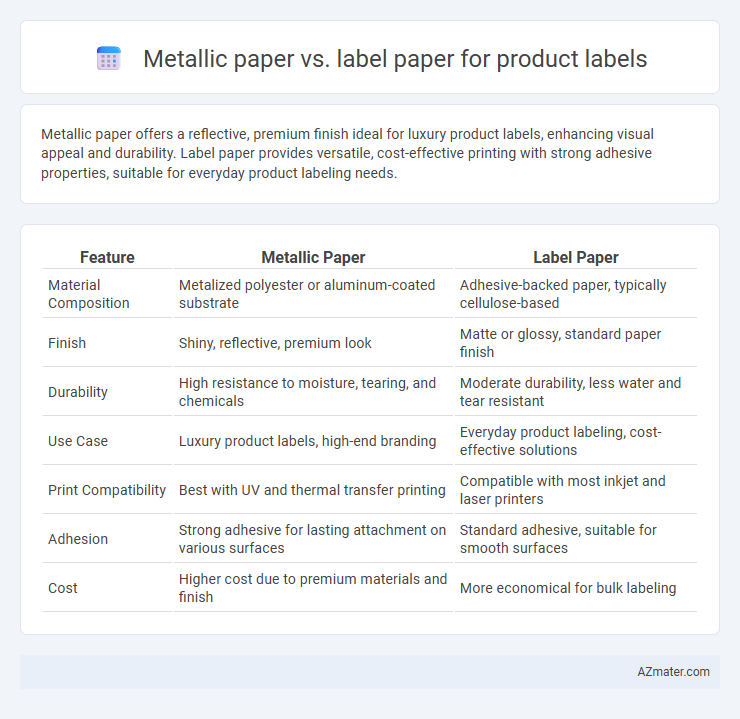Metallic paper offers a reflective, premium finish ideal for luxury product labels, enhancing visual appeal and durability. Label paper provides versatile, cost-effective printing with strong adhesive properties, suitable for everyday product labeling needs.
Table of Comparison
| Feature | Metallic Paper | Label Paper |
|---|---|---|
| Material Composition | Metalized polyester or aluminum-coated substrate | Adhesive-backed paper, typically cellulose-based |
| Finish | Shiny, reflective, premium look | Matte or glossy, standard paper finish |
| Durability | High resistance to moisture, tearing, and chemicals | Moderate durability, less water and tear resistant |
| Use Case | Luxury product labels, high-end branding | Everyday product labeling, cost-effective solutions |
| Print Compatibility | Best with UV and thermal transfer printing | Compatible with most inkjet and laser printers |
| Adhesion | Strong adhesive for lasting attachment on various surfaces | Standard adhesive, suitable for smooth surfaces |
| Cost | Higher cost due to premium materials and finish | More economical for bulk labeling |
Introduction to Product Label Materials
Metallic paper offers a shiny, reflective surface ideal for premium product labels that demand high visual impact and durability, often used in cosmetics and luxury goods. Label paper, typically made from matte or glossy paper, provides cost-effective versatility and ease of printing for everyday product labels in food, beverages, and household items. Choosing between metallic and label paper depends on brand identity, product positioning, and environmental resistance requirements.
Overview of Metallic Paper
Metallic paper for product labels features a reflective, shiny surface that enhances visual appeal and premium perception, making it ideal for luxury or high-end branding. Its durability and resistance to moisture and tearing outperform standard label paper, ensuring longevity and maintaining label integrity in various conditions. The distinct texture and finish of metallic paper also improve color vibrancy and contrast, helping product labels stand out on crowded retail shelves.
Overview of Label Paper
Label paper for product labels varies significantly between metallic paper and standard label paper, each designed for specific branding needs and material compatibility. Metallic paper features a reflective foil surface that enhances visual appeal and durability, making it ideal for luxury products and high-end packaging requiring premium aesthetics. In contrast, ordinary label paper offers versatility and cost-effectiveness, with smooth or matte finishes suitable for a wide range of industries, providing easy printability and adhesive options for everyday labeling applications.
Visual Appeal: Metallic vs Standard Labels
Metallic paper labels offer a reflective, eye-catching finish that enhances brand visibility and conveys a premium feel, making them ideal for luxury or high-end products. Standard label paper provides a matte or gloss finish with more muted tones, suitable for everyday, cost-effective labeling needs while maintaining legibility and clarity. Choosing metallic over standard labels significantly impacts visual appeal by adding depth and shimmer that attract consumer attention in competitive retail environments.
Durability and Resistance Comparison
Metallic paper offers superior durability and resistance against moisture, UV exposure, and physical abrasion, making it ideal for high-end product labels requiring a long-lasting, premium finish. Label paper, while more cost-effective, tends to absorb moisture and wear down faster, which can result in fading, tearing, or peeling especially in harsh environmental conditions. For applications demanding extended shelf life and exposure to external elements, metallic paper provides enhanced structural integrity and resistance compared to standard label paper.
Print Quality and Compatibility
Metallic paper offers superior print quality with vibrant, reflective finishes that enhance the visual appeal of product labels, making colors appear more vivid and eye-catching. Label paper, designed specifically for adhesive applications, provides excellent compatibility with various printers, including inkjet and laser, ensuring sharp image reproduction and durability. While metallic paper excels in premium aesthetics, label paper delivers reliable adhesion and consistent print results suited for everyday product labeling needs.
Application and Adhesion Differences
Metallic paper offers a premium, reflective finish ideal for high-end product labels requiring visual impact and durability on smooth surfaces, while label paper provides versatility with various matte or glossy finishes suited for diverse packaging types. Adhesion on metallic paper is typically stronger on non-porous materials due to its coated surface, whereas label paper adheres effectively to a wider range of substrates, including glass, plastic, and cardboard. Choosing between the two depends on the product's environmental exposure and the desired aesthetic, as metallic paper enhances brand appeal with its shiny effect, unlike the more functional and cost-effective label paper.
Cost Effectiveness: Metallic vs Label Paper
Metallic paper offers a premium appearance but typically comes with higher material and printing costs compared to standard label paper, impacting overall cost effectiveness for product labels. Label paper is more affordable, widely available, and suitable for bulk labeling needs, making it a cost-efficient choice for businesses prioritizing budget over luxury aesthetics. Balancing cost with design requirements is crucial when deciding between metallic and label paper for product labeling.
Eco-Friendliness and Sustainability
Metallic paper for product labels often involves aluminum coatings and non-recyclable components, making it less eco-friendly and challenging to recycle compared to label paper. Label paper, particularly options made from recycled fibers or certified sustainable sources, significantly reduces environmental impact through biodegradability and compostability. Choosing label paper with water-based adhesives further enhances sustainability by minimizing harmful chemical residues in the disposal process.
Choosing the Right Paper for Your Product Label
Metallic paper enhances product labels with a shiny, reflective finish that attracts customer attention and adds a premium look, ideal for luxury or high-end brands. Label paper, particularly matte or glossy options, offers versatility and cost-effectiveness for everyday labeling needs, ensuring clear print quality and durability. Selecting the right paper depends on the product's branding, required durability, and the desired visual impact to effectively communicate the product's identity and appeal.

Infographic: Metallic paper vs Label paper for Product label
 azmater.com
azmater.com